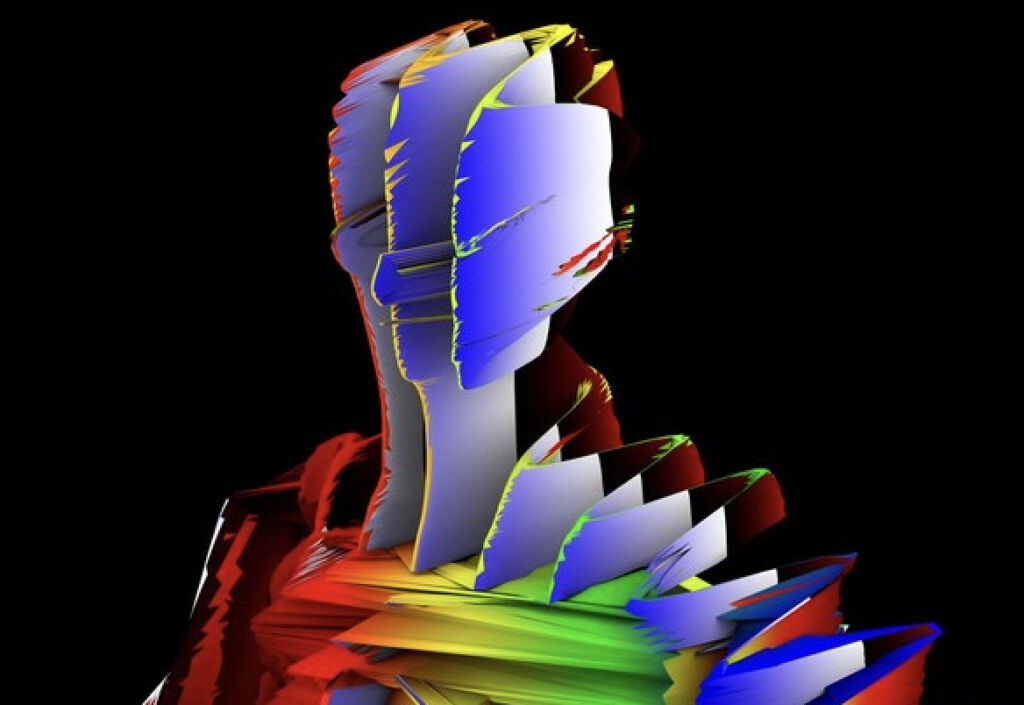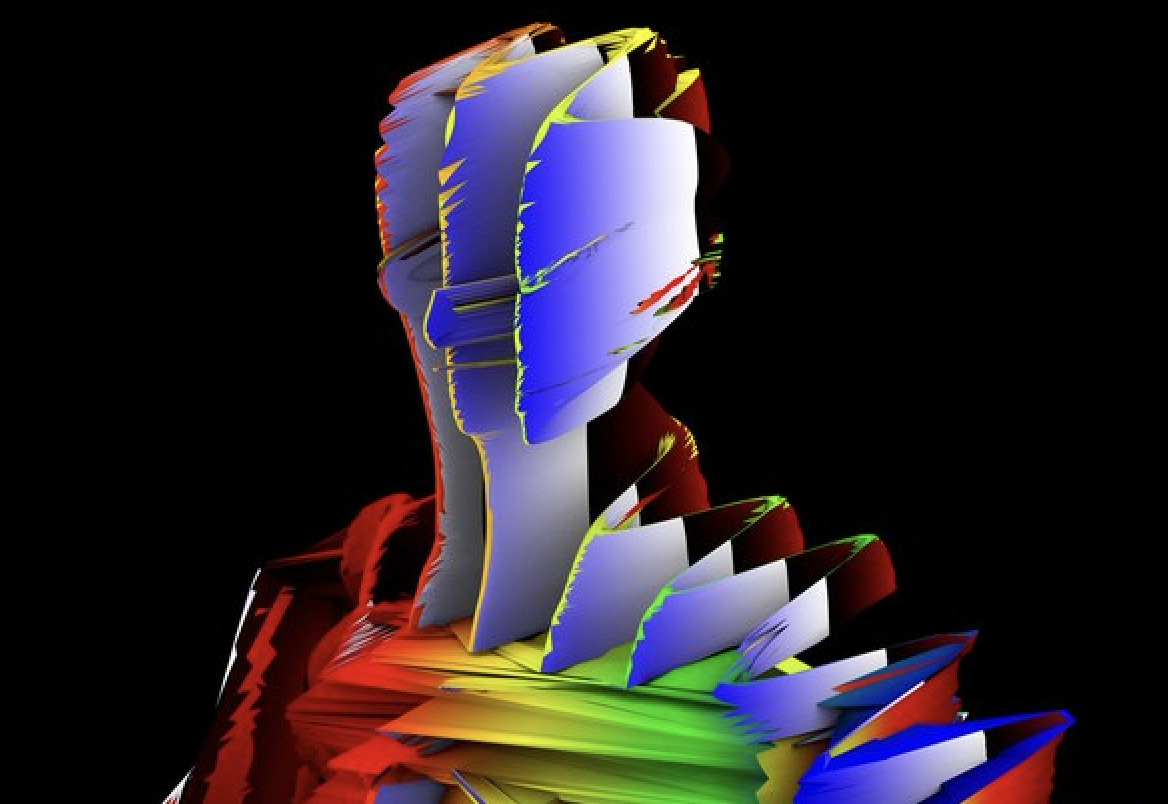Words by Meritxell Rosell

In a shaker, place 1 ½ parts of computerised exotica, ½ part of linguistics, 1 part of ethnography and transculturalism and ¼ part of randomised generative computing. Shake up vigorously and strain the mix into a cocktail glass. To finish up, add a generous splash of lysergic visuals and enjoy the Visible Cloaks experience.
In case you are wondering, Visible Cloaks are musicians Spencer Doran and Ryan Carlile. This Portland-based duo has been putting together a striking combination of music composition and computing techniques, using software-based randomisation, MIDI translation and chance operations, recalling the influence of John Cage’s use of the I Ching and Walter Zimmermann’s application of prime numbers.
Last October, the duo’s live show at Unsound Festival was a perfect opportunity to get a proper taste of their work. Over 40 minutes of intoxicating (in a good way) amounts of saturated colours and patterns with soothing sounds transported us far away from the city’s more wintery landscapes. With material from their recently published mini-LP Lex and previous album Reassemblage (both published in 2017), it was a meditative journey sliding through tapestries of sound and visuals.
Visible Cloaks formulate some of their inspiration from the conceptual ideas behind Haruomi Hosono’s Yellow Magic Orchestra. YMO was a project that attempted to make a twist of Western patronising fetishisation of the “oriental” (ideas also exposed in Edward Said’s seminal book Orientalism (1978)) while at the same time incorporating some Western popular musical elements. Similarly, Jon Hassell’s “fourth world” is a musical concept combining minimalism’s philosophy and techniques with Asian and African styles, grounded on a heavy presence of electronic instruments.
In their last production, the mini album Lex, Visual Cloaks, have been working around concepts of linguistics: language, speech, lexicon and syntax sifted through an array of new digital technologies and the duo’s particular pancultural ideas.
In Lex (a take from the word Lexicon), the idea behind it was to create a language that was a fusion of many, based on a range of voices created by feeding dialects and accents through language translation software to create a kind of incomprehensible new dialect.
The album is an evolution from Permutate Lex, a companion short film, to Lex made by Visible Cloaks and visual artist Brenna Murphy, a long-term friend and collaborator. Her artworks provide a fitting acid-bright uncanny aesthetic to the soothing sounds of the duo.
Murphy also created the artwork for the previous album Reassemblage and several videos for the records. Reassemblage uses a method inspired by Vietnamese filmmaker Trinh T. Minh-ha’s 1982 documentary film, from which the album takes its name. The author perceived music cultures from around the globe without giving any meaning to them. We can’t just ascribe our external meaning to images of other people because meaning is lost when you’re from another culture looking into someone else’s point of view.
These ideas recall Wittgenstein’s linguistic views. In Wittgenstein, one of the major figures of philosophy in the 20th century, there’s a shift from seeing language as a fixed structure imposed upon the world to see it as a fluid structure intimately bound up with our everyday practices and forms of life. Communication involves using conventional terms in a way that a linguistic community recognises. In this sense, Wittgenstein’s philosophy pushes this point of view beyond linguistics into ethnography.
Visible Cloaks music proposes a utopian journey, a space surrounded by fluid musical techniques, abstract voices and evocative synthesis of textures. Expanding their musical philosophy through complex melodic shapes and phrases where this form of transculturalism materialises into enticing futuristic sounds.
You are both musicians, and in previous productions, you’ve pointed out YMO and Jon Hassell as significant influences, taking the central concept of the “fourth world” or possible future of music in which elements from different cultures are integrated. How is their work more precisely reflected in your compositions and instruments?
Both of these references have directed the conversation around our music in a way that has perhaps obscured many of the other ideas at play and often caused the specifics of our own voice to get lost. “Fourth world” has become such a ubiquitous and empty descriptor and so frequently unexamined in its use.
To speak on this in relation to YMO, I always appreciated Hosono’s concept of “sightseeing music” as a way of unpacking the difficult feeling of distance at play in Western ideas like Hassell’s “fourth world” – reframing it as a form of sonic tourism in a semi-serious fashion were it is difficult to parse the true intention of the artist – is it a put on? I appreciate art that doesn’t offer easy answers or where artists’ intentions aren’t specific or clear. So similar to Hosono, we are working with this idea but also attempting to unravel it simultaneously, or at least not discount its absurdity.
Your most recent album, Lex, seems to explore quite complex ideas of communication, even proposing a utopian dream language. Could you tell us more about the intellectual process behind the album concept?
Lex spiralled off of the video piece Permutate Lex, a collaboration with visual artist Brenna Murphy, which was initially commissioned as a visual extension of Reassemblage but ended up expanding beyond it – that expanse served as the starting point for Lex, particularly the speech fragments. It arose out of an interest in the concept of interlanguage or international auxiliary language: things like Volapük, Esperanto or Solresol, “constructed” languages that were intended (with a perhaps naive optimism) to help the human race transcend linguistic barriers to form a unified, global form of communication.
Also, Brenna and I are both big fans of a book by Ursula K Le Guin called Always Coming Home, which is a fictional ethnography of a tribe in a post-apocalyptic future, replete with a language and a survey of its musical traditions so that created of a prospective history served as an inspiration too. Our approach was to create this heavily abstracted window into a prospective future with evolved post-human figures speaking in a language that only vaguely hints at familiarity from our contemporary viewpoint.
Familiar because it has collapsed various aspects of past linguistics into a universal form…from our vantage point of the present, this language doesn’t make much sense, and the images of their world seem foreign and dreamlike. It’s a utopian idea in so much as it underscores the failures of our current present – a place where this form of “universal” communication or transculturalism feels distant and impossible.
In Lex too, Spencer created a new non-language, feeding a chain of multiple dialects and accents through a language translation software to create an auditory poetry of an evolved place and time. How and when does the interest in linguistics come from a novel technological perspective? Do you have any scientific background?
Linguistics certainly interests me, but I have no real academic training in the particulars of it – the same is true about science. My methodology is very much hacked together by consumer-grade, free online tools…I must admit that my process and research are far from rigorous (at least in an academic sense). Still, it’s a reflection of my generation’s relationship with technology like Google Translate and the sense of mistrust within it.
These translation chains end up magnifying the poetic failures or communications lapses that occur within translation software, and the results are both a reduced linguistic essence and a bi-product of the inability of the machine to truly understand the poetics of human communication: the nuances of language get lost in the shuffle, resulting in an entropy of meaning. It has the potential to be funny, beautiful and unsettling (in an “uncanny valley” sort of way), sometimes all at once.
Early this year, two Facebook bots left to interact and respond to each other ended up developing their own language without human intervention. In your case, having researched about and worked with an artificially generated language, what was more surprising or unexpected about it?
I was a little disappointed reading about that the first time, as the “language” was just a garbled version of English where the rules of syntax became distorted – I guess I didn’t find it all that surprising. Oddly the experiments that I’ve done with Google Translate have somewhat of a similar distorted syntax if you translate them back into the original source langue (English, in my experiments) at the end of the chain – syntax seems to be the first thing to go out the window, and what too often end up with is a bunch of jumbled morphemes, similar to the bot language.
As syntax and grammar are so variable from language to language, this makes a lot of sense – and I see how the same thing could happen with bot conversations as grammar is a fairly malleable element when the language evolves – the evolutions that English has undergone even within my own lifetime (texting abbreviations, compacted and re-arranged Twitter grammar, etc.) is emblematic of this. I’m waiting for the time when bots start making up their own phonemes and morphemes that can’t be represented by any human alphabet – I doubt it’s far off.
You developed Lex album artwork and lived show with audiovisual artist Brenna Murphy. What were the biggest challenges when developing the project and finding a common language that reflected the album concepts?
It’s never really been much of a challenge working with Brenna, as we’ve all known each other for a long time now, and I suppose there’s a certain sense of artistic trust. The forms and environments she’s created to act as visual avatars for our musical work are abstract enough that it becomes easy to connect musical meaning to them – and the inverse is true with our abstract musical forms being easy to connect to a visual idea.
The more sci-fi dimension of the backstory behind the video piece and the EP is certainly something that arose in the middle of the process (as opposed to being an impetus that guided us initially), so certain concepts arise from working with this abstract material, a “common language” that forms.
Your chief enemy of creativity?
The blank page. For me, work often starts by interpreting or contorting an external stimulus, be it something generated randomly, created by musically analyzing something non-musical, an idea from elsewhere, etc. – then working with that as a starting point. These kinds of tools help jumpstart the creative process but also help to work around the entrapments of ego that are often woven into this same process – for me, it is helpful to place aspects of the decision-making outside of one’s self.
You couldn’t live without…
Hard question! Family, culture, experiences/impressions, growth, good food, air.






